I noticed one of his pics shows the 2500CC oil level casting on it. I'm not an expert on years but wasn't that change made on the 447 motors?
-
Enjoy XS650.com? Consider making a donation to help support the site.
XS650.com receives a small share of sales from some links on this page, but direct donations have a much greater impact on keeping this site going.
You are using an out of date browser. It may not display this or other websites correctly.
You should upgrade or use an alternative browser.
You should upgrade or use an alternative browser.
Burger's Build
- Thread starter 650Burger
- Start date
You really have to pin down whether you're working with an older or early engine because there's several big internal differences. The cam chain is a different pitch and length. The cam chain sprockets are different sizes and also made to fit the early different chain pitch. That little sprocket on the rear tensioner probably also wouldn't fit and mate up well with a later cam chain because it was matched to an early one.
The engine code is 2F0 - 104133
This matches up with a xs-se from 78-79 if I'm reading the chart on thexscafe right.
The frame code is 3GO - 003839 which matches up with a 1980 XS-G.
Since the engine is a US engine built after 74, from what I gather from various forums they have interchangeable parts. (correct me if I'm wrong, this is just after some research on my part)
Link to thexscafe for those interested in reading engine codes:
https://thexscafedotcom.wordpress.com/2011/09/29/xs650-model-year-model-code-engine-number/
You'll need to see what your spare engine has for an adjuster. As 5T point's out, that ain't the right one for that motor. Come to think of it, does the spare engine # match the frame? If so, might be better to build that one up.
You'll need to see what your spare engine has for an adjuster. As 5T point's out, that ain't the right one for that motor. Come to think of it, does the spare engine # match the frame? If so, might be better to build that one up.
I got a fresh adjuster from heiden, correct for the later 447 engines. I will check the number on the spare engine!
Hmmmmm..... Okay. Kind of a stupid question here, but, before you started the tear-down, was your bike running? If it did, what did it sound like? (nice & smooth, coughing & farting, or like a box of busted dishes?) As 5Twins and Jim have mentioned, you could have a bunch of mis-matched parts that won't want to work and play well with others. Cross-check and verify your engine numbers, to make sure you know what you have. The more homework you do, the fewer surprises you get. All seriousness aside, these motors are really only slightly more complicated than a lawn mower. And unless there's something tragically wrong, they can't not run (yeah, okay, I employed a double negative  ). Don't let it intimidate you into thinking you can't tear it down and put it back together better than ever!
). Don't let it intimidate you into thinking you can't tear it down and put it back together better than ever! 
 ). Don't let it intimidate you into thinking you can't tear it down and put it back together better than ever!
). Don't let it intimidate you into thinking you can't tear it down and put it back together better than ever! 
Hmmmmm..... Okay. Kind of a stupid question here, but, before you started the tear-down, was your bike running? If it did, what did it sound like? (nice & smooth, coughing & farting, or like a box of busted dishes?) As 5Twins and Jim have mentioned, you could have a bunch of mis-matched parts that won't want to work and play well with others. Cross-check and verify your engine numbers, to make sure you know what you have. The more homework you do, the fewer surprises you get. All seriousness aside, these motors are really only slightly more complicated than a lawn mower. And unless there's something tragically wrong, they can't not run (yeah, okay, I employed a double negative). Don't let it intimidate you into thinking you can't tear it down and put it back together better than ever!

The bike was hard to start, and once it started it would smoke (white) for a bit before settling down. It did not sound good, like a bunch of change in a metal jar. It ran okay though, pulling well and breathing okay. No leaks exept clutch pushrod (I'll get to that eventually)
The P.O had made a great list when selling me the bike and I knew the sound was the cam chain guide being bad. He mentioned the chain tensioner being an "older, mismatched" type for the engine.
I did verify my engine type was indeed a "2F0", from the first specials. The frame doesn't match it though.
I'm happy I caught the fact my cam and rockers were in such bad shape, and am swapping in the cam from my spare engine. Should give more life to this engine.
Thanks for the encouragement!
Ha... from the book Zen and the Art of Motorcycle Maintenance....It did not sound good, like a bunch of change in a metal jar. It ran okay though
"This old engine has a nickels-and-dimes sound to it. As if there were a lot of loose change flying around inside. Sounds awful, but it’s
just normal valve clatter. Once you get used to that sound and learn to expect it, you automatically hear any difference. If you don’t
hear any, that’s good."
Of course, Persig was referring to an old Honda twin, but very similar engine and definitely built in the same era with the same technology.
I believe that change was made in 72 with the E-Start engines. Both my 72 motors say 2500CC.I noticed one of his pics shows the 2500CC oil level casting on it. I'm not an expert on years but wasn't that change made on the 447 motors?
The combustion chamber is a steel insert into the head so you can safely finish your clean-up using the little wire wheels in a Dremel to get the rest of that carbon off. Finish it off using some chrome cleaner. Here's one I did and as you can see, they come out pretty much spotless .....

So, from the engine serial number, it appears you have a later 447 motor, at least the bottom end anyway. Maybe the P.O. just swapped in that older, incorrect cam chain tensioner, as he said. Or maybe the complete upper end is swapped (cylinders, head). I would still recommend counting the teeth on the cam sprocket to confirm it's the later, newer type.
So, from the engine serial number, it appears you have a later 447 motor, at least the bottom end anyway. Maybe the P.O. just swapped in that older, incorrect cam chain tensioner, as he said. Or maybe the complete upper end is swapped (cylinders, head). I would still recommend counting the teeth on the cam sprocket to confirm it's the later, newer type.
Counting teeth on the cam (36) would confirm everything, but I'd say you're good. The fact that it ran instead of bending valves confirms the bottom and top end are compatible. I suppose it's possible the PO put a 256 cam and crank in there, but it's much more likely it's just the wrong tensioner.
Ha... from the book Zen and the Art of Motorcycle Maintenance....
"This old engine has a nickels-and-dimes sound to it. As if there were a lot of loose change flying around inside. Sounds awful, but it’s
just normal valve clatter. Once you get used to that sound and learn to expect it, you automatically hear any difference. If you don’t
hear any, that’s good."
Of course, Persig was referring to an old Honda twin, but very similar engine and definitely built in the same era with the same technology.
I really need to re-read that book, it was such a good read. That's the perfect quote to describe it!
The combustion chamber is a steel insert into the head so you can safely finish your clean-up using the little wire wheels in a Dremel to get the rest of that carbon off. Finish it off using some chrome cleaner. Here's one I did and as you can see, they come out pretty much spotless .....

So, from the engine serial number, it appears you have a later 447 motor, at least the bottom end anyway. Maybe the P.O. just swapped in that older, incorrect cam chain tensioner, as he said. Or maybe the complete upper end is swapped (cylinders, head). I would still recommend counting the teeth on the cam sprocket to confirm it's the later, newer type.
Thanks, I definitely need to get those combustion chambers looking cleaner... I don't like having them that dirty.
A couple of pictures from my base gasket, post-cleaning.
There is no more of the paper residue, but there is discoloration on the metal... What I used: permatex gasket remover + Plastic scraper, brakleen red, paint stripper (some eco non toxic kind) then did one round of aircraft paint stripper. Spent about 6 hours on it total.
Does the surface need to be cleaner than that? Looking at other build threads, the surface is perfect...
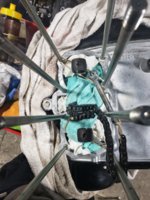
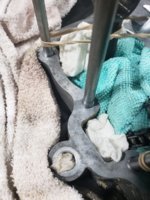
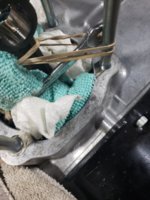
There is no more of the paper residue, but there is discoloration on the metal... What I used: permatex gasket remover + Plastic scraper, brakleen red, paint stripper (some eco non toxic kind) then did one round of aircraft paint stripper. Spent about 6 hours on it total.
Does the surface need to be cleaner than that? Looking at other build threads, the surface is perfect...



You probably won't get it much cleaner than that. You could try rubbing it down with lacquer thinner. That might remove some of the discoloration and any last remaining bits of gasket and/or gasket sealer. Do wipe it down with lacquer thinner again just prior to assembly. That will remove any dirt or oil that may has gotten on it during your rebuilding process, even oil from your fingers. I wipe all the gasket surfaces down just prior to reassembly like this. A small pint or half pint can of lacquer thinner is only a few dollars from the paint department at your local hardware store and should be considered a "must have" item when engine building in my opinion. It cleans the gasket surfaces very well, dries quickly, and doesn't leave behind any residue to speak of.
So I went back to my head and rocker cover... and learned how to use the vapor blaster and got them looking way better than they were. I'm actually very happy with them now
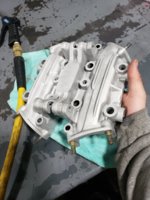
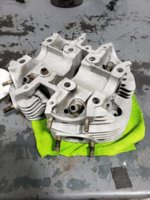
I have spent a significant amount of time washing them yesterday but the garage only had cold water. I am going to clean them again in my sink at home, I don't want to have any blasting media left over.
Hopefully today will be rocker cover reassembly and putting the valves back on. Any advice? Should I oil everything (rockers, rocker shafts) while rebuilding?


I have spent a significant amount of time washing them yesterday but the garage only had cold water. I am going to clean them again in my sink at home, I don't want to have any blasting media left over.
Hopefully today will be rocker cover reassembly and putting the valves back on. Any advice? Should I oil everything (rockers, rocker shafts) while rebuilding?
Use something oil if nothing else. I like assembly lube on everything except piston. Light weight oil for pistons. Some guys like to use grease on cams, followers ect.

I've always used STP oil treatment. Nice sticky stuff designed to dissolve into the oil once the lubrication system is pressurized .I think I use it because of nostalgia for the turbine cars and of course Andy.
Is it any good on toast?I like assembly lube on everything

 Sorry. I couldn't help myself...
Sorry. I couldn't help myself...Similar threads
- Replies
- 9
- Views
- 217
